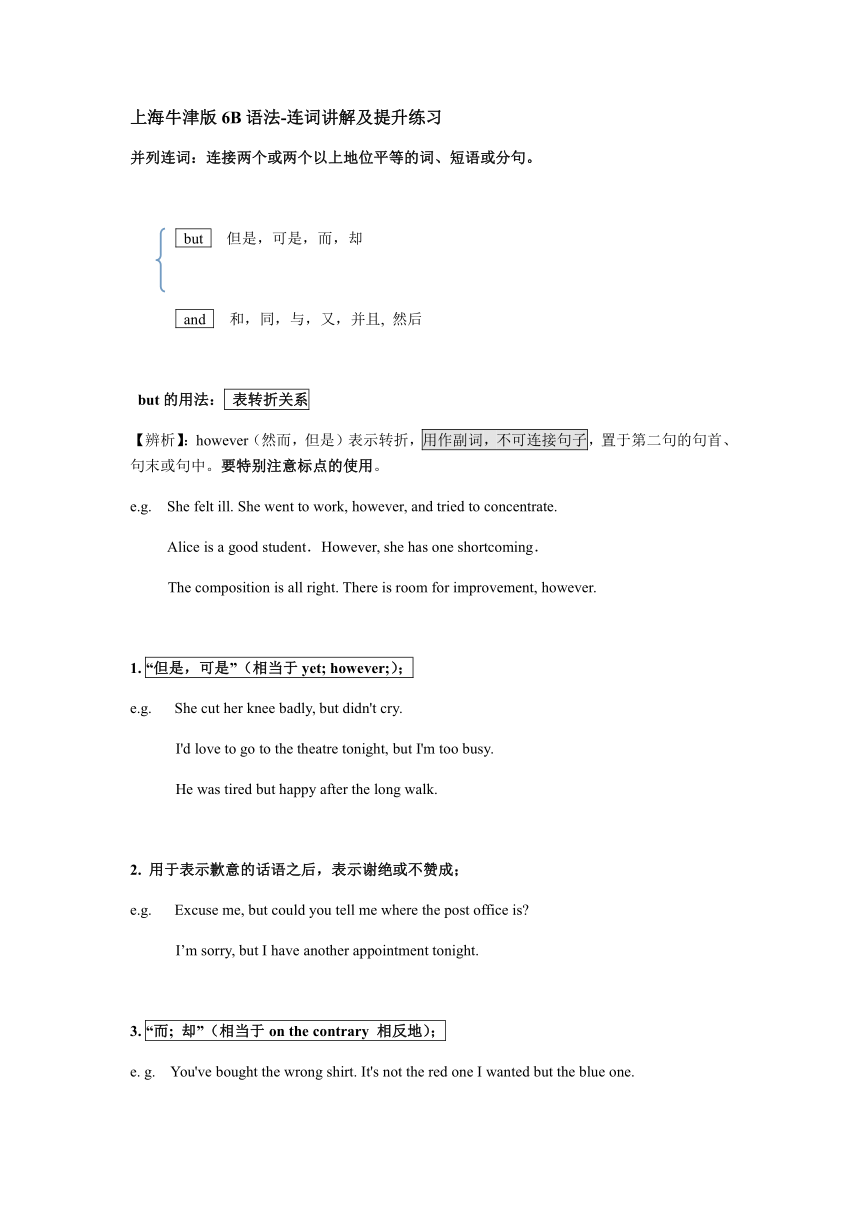
上海牛津版6B语法-连词讲解及提升练习 并列连词:连接两个或两个以上地位平等的词、短语或分句。 but 但是,可是,而,却 and 和,同,与,又,并且, 然后 but的用法: 表转折关系 【辨析】:however(然而,但是)表示转折,用作副词,不可连接句子,置于第二句的句首、句末或句中。要特别注意标点的使用。 e.g. She felt ill. She went to work, however, and tried to concentrate. Alice is a good student.However, she has one shortcoming. The composition is all right. There is room for improvement, however. 1. “但是,可是”(相当于yet; however;); e.g. She cut her knee badly, but didn't cry. I'd love to go to the theatre tonight, but I'm too busy. He was tired but happy after the long walk. 2. 用于表示歉意的话语之后,表示谢绝或不赞成; e.g. Excuse me, but could you tell me where the post office is? I’m sorry, but I have another appointment tonight. 3. “而; 却”(相当于on the contrary 相反地); e. g. You've bought the wrong shirt. It's not the red one I wanted but the blue one. Tom went to the party, but his brother didn't. 4. 含“but”的习惯搭配: ① “not... but...”意为“不是...而是...”,连接两个并列的名词、形容词、副词、短语或分句等; Bamboo is not a tree, but a kind of grass. He failed not because he isn't clever but because he didn't work hard. ② have no choice but to do ... 除了...,别无选择 / do/does/did nothing but do... 除了...,别无他事可做 ③ not only ...but also ...意为“不但...而且...;既...又...”,连接两个并列成分 【考例】 -- Would you like to come to dinner tonight? -- I'd like to, ___ I'm too busy. A. and B. so C. as D. but [答案]D。but与前面形成转折,符合语意。而表并列的and, 结果的so,原因的as都不符合句意。 【考例】--Would you like to come to my house for dinner tonight? --I'd love to, I have lots of work to do. A. so B or C. and D.but [答案]D。[解析]考查转折连词。so(表结果),or(表选择),ad(表并列),but(表转折),根据句意:“我很乐意去, 但我还有一些事要做”可推断选but,表转折。 【考例】It was very cold and windy, _____ those farmers were working hard on the farm. A. and B. or C. but D. so [答案]C。[解析]考查连词的用法。 but表转折,and表并列,or表选择,so表顺接。根据句意选C。 and 的用法: 用来连接语法上同类的词、短语或句子。 1. “和”、“又”、“并且”(相当于also; in addition to); e. g. bread and butter 面包和黄油 slowly and carefully 缓慢而仔细地 Tidy up your room. And don't forget to make your bed! She came in and sat down. 她进来以后就坐下了。 【注意】:并列结构中,and用于肯定句,通常否定句用or。 e. g. There is no air or water in the moon. He can't read or write. 2. “加”(相当于plus),连接两个数字,谓语动词用单数。 e. g. 5 and 5 makes 10. 5加5等于10。 3. 用在祈使句后,表示结果,意为“那么, 就” 。 e. g. Work hard and you will succeed. 努力干吧,你会成功的。 4. 常见搭配: e. g. go and fetch 去拿 come and look at 来看看 wait and see 等着瞧吧 and so on等等 try and improve. 尽量改进 two thousand, two hundred and sixty four 二千二百六十四 【考例】--I don't like chicken ___ fish. --I don't like chicken, ___ I like fish very mu ... ...
~~ 您好,已阅读到文档的结尾了 ~~

